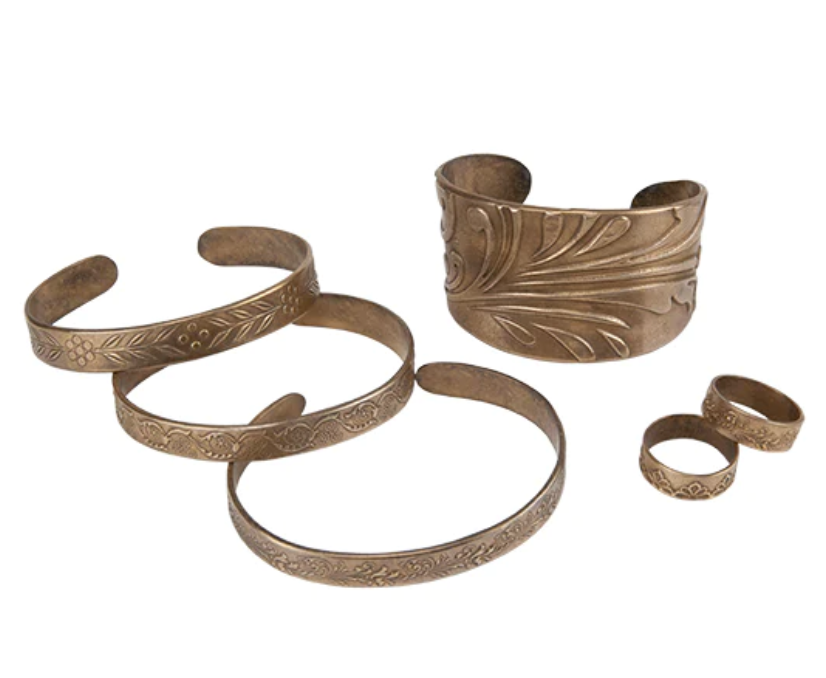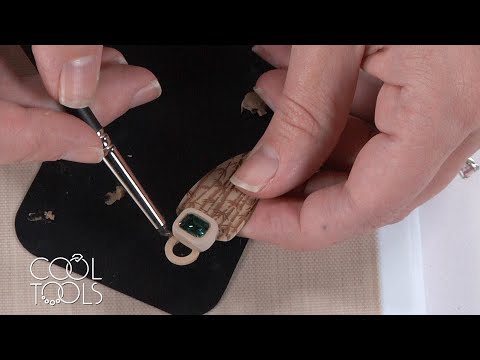



Aureus™ Bright Bronze Clay 50gr & 100 gram packs
$29.95 - $49.95$27.20
Developed by Cindy Silas, Aureus Bright Bronze Clay is an excellent base metal clay medium for jewelry, crafts, sculpture and models. Offered in lump (wet) form, this clay results in a beautiful, bright bronze when fired. Economical, easy to form, fire and finish.
Kiln Fire: 2 Stage - Carbon Required
Shrinkage: 10-11%
Made in the USA
Click here for pdf download of instructions here
Greenware and Dry Construction
In its greenware state, the clay is slightly flexible and carves easily. Air drying the unfired clay or greenware without heat will reduce the potential for warping as the clay dries. Once completely dry, the greenware should be handled with care as it can be fragile. It is much easier to sand and refine the greenware at this stage than to refine the metal once sintered. When joining pieces, create a paste slurry at the join with water, then compress both pieces together for 30 seconds. Put aside to dry completely. Metal clay must be completely dry before firing.
Embedding Objects
Cubic Zirconia, lab created gemstones, Nano gems, bezel cups, and other findings or embeddables can be co-fired with Aureus Bright Bronze Clay. Please refer to our Gemstone Firing Guide for a comprehensive list of gemstones that are compatible with the firing times and temperatures of Aureus Bright Bronze clay. Most, but not all, CZs, Nano gems, and lab created gemstones can be fired at 1400°F/ 760°C for 2 hours.
Firing
Aureus Bright Bronze Clay requires a two phase firing. The first Phase completely burns out the binder, which helps the work sinter properly in the second phase. Many kilns fire hotter or cooler than their digital read-outs state. It is a good idea to test your kiln for temperature accuracy. This can be done with a hand-held digital pyrometer.
Phase 1
Full ramp to 650°F/ 343° and hold for 30 minutes -Option 1 Arrange greenware on a mesh firing rack. Additional pieces can be stacked using more mesh firing racks separated with kiln posts. Raise the mesh firing rack(s) off the kiln floor with a few more kiln posts for air circulation. -Option 2 The greenware can be placed on top of 1'' of activated carbon in a steel firing container. Do not add activated carbon on top of the greenware for phase 1 firing. Laying flat can create little indents because bronze gets soft while sintering. Best to lay flat pieces vertical in the carbon. Note | A slower phase 1 firing is needed for any piece that has areas that are 3mm (12 cards) thick or thicker. Ramp 300°F/ 149°C hour to 600°F/ 315°C and hold for 15 minutes.
Phase 2
Full ramp to 1400°F/ 760°C and hold for 2 hours Once the greenware has cooled enough to handle after the first firing phase, gently transfer the work to a kiln vessel, such as a steel firing container that has at least 1'' of activated carbon spread on the bottom. Arrange the pieces with at least 1/2'' of space between them. Cover all pieces with at least 1'' of activated carbon. Additional work can be added in layers as long as there is 1'' of activated carbon above and below each piece. Fire with a slotted lid or lid ajar. Do not cover firing container completely.
Firing Media
Coconut Carbon is recommended. Coal Carbon will also produce successful results. Magic Carbon is not recommended for use with Aureus Bright Bronze Clay as it may complicate the use of embeddables, bezel settings, and repairs, causing an increased or uneven shrink rate. It may also increase the shrink rate of the clay. We recommend creating a small test piece and fire per the schedule before committing complex work to firing.
Shrinkage
During firing, this clay shrinks 10-11% as a result of the organic binders burning off (phase 1) and also the sintering process (phase 2).
Finishing and Polishing
Once firing is complete, it is best, but not necessary to let the work cool completely. Place a mesh firing rack over an emptysteel container. Poor the contents of the fired container through the firing rack into the empty steel container to retrieve the sintered bronze. The metal can then be polished using a wire brush, rotary tools, a tumbler, or other polishing tools.
Patination
To Achieve a dark result from Liver of Sulfur (LOS) or Cool Tools Patina Gel, ensure that the work piece is absolutely clean by soaking and then brushing with hot water, soap, and ammonia. Using a strong solution of LOS in very hot water, dip or soak the solution until the desired darkness is achieved. Adding a teaspoon of ammonia to the LOS bath can also help achieve a darker result or, possibly, a rainbow effect. After the desired patina has been achieved, thoroughly rinse your piece to cleanse it of all remaining LOS to halt the patination process. Then, either by hand or by machine, bring up the high points with a polishing cloth, Scotch-Brite pad (satin finish), or polishing wheels (high shine). If desired, protect the patina with a coat of Everbrite™ Protecta Clear® or Permalac ClearCoat Spray.
Soldering
Once fired, this bronze clay is metallurgically just like other bronze metals, but, like other fired metal clays, it is more porous than sheet stock or cast items. Due to this porosity, this bronze clay will ''soak up'' solder. When possible, prepare areas for soldering by burnishing to close the open pores and reduce the tendency to absorb solder. Join other metals and findings to fired bronze clay by using the same flux, solder, and torch(es) as you would to solder other bronze products.
Storing
Unused clay can be placed in plastic wrap and stored in a Cool Tools Clay Hydrator to keep it moist.
Rehydrating
Unfired clay can be rehydrated. Large dried pieces can be put into a heavy plastic bag and hit with a mallet to break up the pieces. A dedicated coffee bean grinder can then pulverize the smaller pieces back into a fine powder. It is recommended to wear a dust mask when working with any kind of powder. Pour the desired amount of powder into a small bowl. Add 7 ml distilled water for every 50 grams of powder, then stir. Transfer the clay to a lightly oiled plastic sheet such as a sheet protector. Fold the sheet over, then flatten the clay with a roller. Do not over wet the clay, but do add another spritz of distilled water if needed. If you do over wet the clay, put it aside until some of the water has evaporated. Continue refolding the sheet and rolling until the clay is lumping together and no longer sticking to the plastic sheet. Either lightly oil your hands or use vinyl gloves to further knead the clay into a well-mixed lump. Now it's ready to use!



